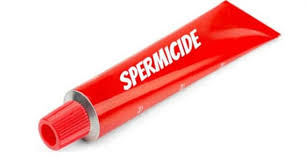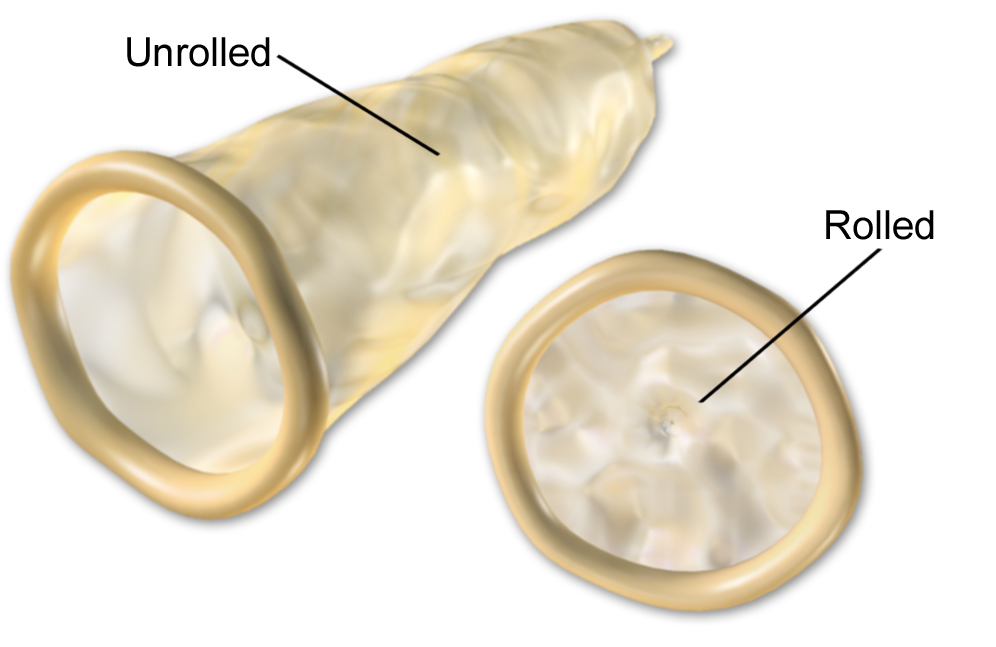Science > Biology > Human Population and Population Control > Barrier Methods of Contraception
Barrier methods of contraception act as barriers to keep the man’s sperm from reaching the woman’s ovum (egg). Some barrier methods also protect against sexually transmitted infections (STIs). The common barrier methods are spermicide, condom, fem shield, diaphragm, cervical cap, vault cap, and sponge, etc.
Spermicide:
Spermicide is a kind of birth control that has chemicals that stop sperm from reaching an egg. Spermicide doesn’t actually “kill” sperm, but it slows it down so it can’t reach an egg. This is chemical-barrier method of contraception. The chemicals in the spermicide, such as nonoxynol-9, prevent sperm from entering the uterus. It is put in the vagina of the female before sex to prevent pregnancy. It blocks the entrance to the cervix, so sperm can’t approach the ovum, and also stops sperms from moving well enough to swim to the ovum. Spermicide comes in many different forms: creams, gels, film, foams, and suppositories (soft inserts that melt into a cream inside the vagina). They have no effect on a woman’s natural hormones.

It is not a very effective birth control method when used alone. Its effectiveness can be improved by using it with a condom, diaphragm or cervical cap. Using spermicides several times a day may irritate the vagina and damage the tissues lining it. As a result, the microorganisms that cause sexually transmitted diseases (including HIV) can more easily enter the body and cause disease. Spermicide doesn’t protect against sexually transmitted infections.
Condom:
It is the most used Barrier methods of contraception. A male condom is thin protective tubular latex sheaths that cover the penis. Condoms made of latex are the only contraceptives that provide protection against all common sexually transmitted diseases (STDs), including those due to bacteria (such as gonorrhea and syphilis) and those due to viruses (such as HPV—human papillomavirus—and HIV—human immunodeficiency virus). Condom traps ejaculated sperms during coitus. They have no effect on a woman’s natural hormones. In India Government supplies condom with the brand name “NIRODH” at family welfare centres at free of cost or at a very nominal cost. The female condom (vaginal pouch) is a pouch with an inner and an outer ring. The inner ring is inserted as far as it can go into the vagina, and the outer ring remains outside. During sexual intercourse, the penis is passed through this tube. A condom is the safest method to avoid pregnancy.


Condoms must be used correctly to be effective. Condoms should be applied before penetration. A new and the correct size condom for each act of sexual intercourse should be used.
Diaphragm:
The diaphragm is a dome-shaped rubber cup with a flexible rim. It is inserted into the vagina and positioned over the cervix. A diaphragm prevents sperm from entering the uterus. The diaphragm must be fitted by a health care practitioner, who also teaches the woman how to insert it. A diaphragm should cover the entire cervix without causing discomfort. Neither the woman nor her partner should notice its presence. Spermicidal cream or gel should always be used with a diaphragm. It has no effect on a woman’s natural hormones.

The diaphragm is inserted before intercourse and should remain in place for at least 6 and probably 8 hours but no more than 24 hours. Diaphragms can be washed and reused. A woman should inspect the diaphragm regularly for tears. This is not the safest method to avoid pregnancy. The diaphragm does not protect against STIs, including HIV. The spermicide used can increase the risk of getting HIV from an infected partner.
Cervical cap:
The cervical cap, a hat-shaped silicone cup (nipple), is inserted into the vagina and positioned over the cervix. A cervical cap prevents sperm from entering the cervix. Cervical caps resemble diaphragms but are smaller and more rigid. Spermicidal cream or gel should always be used with a cervical cap. The cap is inserted before sexual intercourse and left in place at least 6 hours after intercourse, up to 48 hours at a time.

The cervical cap can be washed and reused. A woman should inspect the cervical cap regularly for tears. It has no effect on a woman’s natural hormones. This is not the safest method to avoid pregnancy. The cervical cap does not protect against STIs, including HIV. The spermicide used can increase the risk of getting HIV from an infected partner.
Vault Cap:
It is semispherical dome-shaped rubber or plastic cap with a thick rim. It is fitted over vaginal vault over the cervix before coitus and can be removed by only six hours after the intercourse. The vault cap does not protect against STIs, including HIV. The spermicide used can increase the risk of getting HIV from an infected partner.

Contraceptive Sponge:
A contraceptive sponge is round, pillow-shaped polyurethane sponge about 1 1/2 in (4 cm) in diameter. The sponge is wet with water, folded, and inserted deep into the vagina, where it blocks sperm from entering the uterus. The sponge also contains a spermicide. Neither the woman nor her partner notices its presence during intercourse. The sponge can be inserted into the vagina by the woman up to 24 hours before sexual intercourse.

The sponge must be left in place for at least 6 hours after the last act of intercourse. It should not be left in place for more than 30 hours. It has no effect on a woman’s natural hormones. Each sponge contains enough spermicide for repeated acts of sex during a 24-hour period. The sponge does not protect against STIs, including HIV. The spermicide used can increase the risk of getting HIV from an infected partner.
We can see that in barrier methods of contraception the meeting of sperm and ovum is avoided. Except for condom (nondefective), all other barrier methods of contraception are not sure of avoidance of pregnancy.
Previous Topic: Natural Methods of Contraception
Next Topic: Intrauterine Devices (IUDs) as Contraceptives